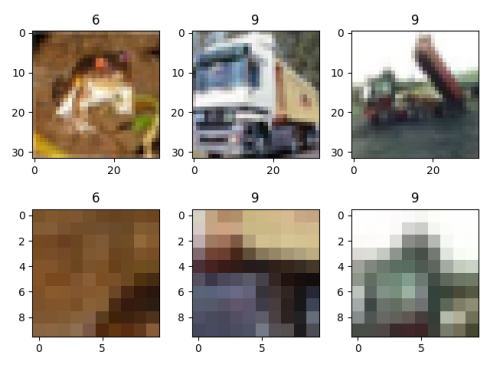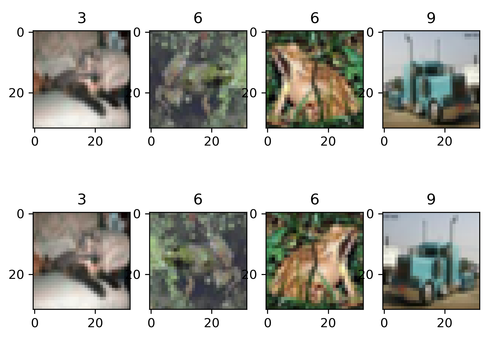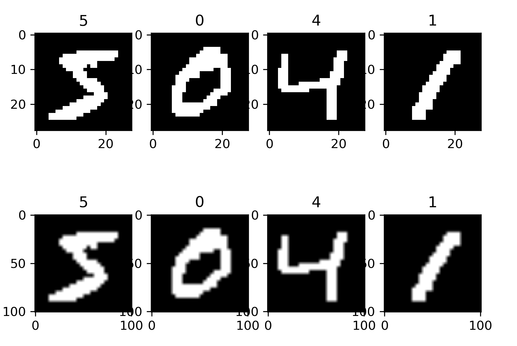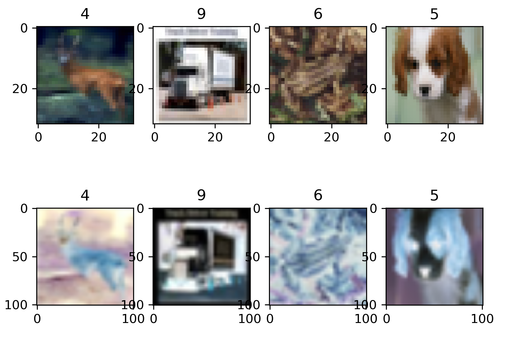Image Data Processing and Enhancement
Ascend GPU CPU Data Preparation
Overview
In a computer vision task, if the data volume is small or the scenario of the samples are simple, the training effect will be affected. In this case, you may preprocess images by performing data augmentation, so as to improve generalization of the model.
MindSpore provides the c_transforms and py_transforms modules for data augmentation. You can also customize functions or operators to augment data.
Module |
Implementation |
Description |
|---|---|---|
c_transforms |
Implemented based on C++. |
This module provides high performance. |
py_transforms |
Implemented based on Python PIL |
This module provides multiple image augmentation methods and can convert PIL images to NumPy arrays. |
The following table lists the common data augmentation operators supported by MindSpore. For details about more data augmentation operators, see MindSpore API.
Module |
Operator |
Description |
|---|---|---|
c_transforms |
RandomCrop |
Crops an image of a specified size at a random position. |
RandomHorizontalFlip |
Flips the image horizontally based on the specified probability. |
|
Resize |
Resizes the image to the specified size. |
|
Invert |
Inverts the image. |
|
py_transforms |
RandomCrop |
Crops an image of a specified size at a random position. |
Resize |
Resizes the image to the specified size. |
|
Invert |
Inverts the image. |
|
Compose |
Performs the data augmentation operations in the list in sequence. |
c_transforms
The following describes how to use common data augmentation operators of the c_transforms module.
RandomCrop
Crops the input image at a random position.
Parameter description:
size: size of the cropped image.padding: number of padded pixels.pad_if_needed: specifies whether the original image needs to be padded when it is smaller than the cropped size.fill_value: fill value used in the constant fill mode.padding_mode: padding mode.
The following example uses a sequential sampler to load the CIFAR-10 dataset [1], randomly crops the loaded image to 10 in both length and width, outputs the image shapes and labels before and after cropping, and displays the cropped image.
Download CIFAR-10 dataset and decompress it to the specified path, execute the following command:
wget -N https://mindspore-website.obs.cn-north-4.myhuaweicloud.com/notebook/datasets/cifar-10-binary.tar.gz --no-check-certificate
mkdir -p datasets
tar -xzf cifar-10-binary.tar.gz -C datasets
mkdir -p datasets/cifar-10-batches-bin/train datasets/cifar-10-batches-bin/test
mv -f datasets/cifar-10-batches-bin/test_batch.bin datasets/cifar-10-batches-bin/test
mv -f datasets/cifar-10-batches-bin/data_batch*.bin datasets/cifar-10-batches-bin/batches.meta.txt datasets/cifar-10-batches-bin/train
tree ./datasets/cifar-10-batches-bin
./datasets/cifar-10-batches-bin
├── readme.html
├── test
│ └── test_batch.bin
└── train
├── batches.meta.txt
├── data_batch_1.bin
├── data_batch_2.bin
├── data_batch_3.bin
├── data_batch_4.bin
└── data_batch_5.bin
2 directories, 8 files
import matplotlib.pyplot as plt
import mindspore.dataset as ds
import mindspore.dataset.vision.c_transforms as c_trans
ds.config.set_seed(5)
ds.config.set_num_parallel_workers(1)
DATA_DIR = "./datasets/cifar-10-batches-bin/train/"
sampler = ds.SequentialSampler(num_samples=3)
dataset1 = ds.Cifar10Dataset(DATA_DIR, sampler=sampler)
random_crop = c_trans.RandomCrop([10, 10])
dataset2 = dataset1.map(operations=random_crop, input_columns=["image"])
image_list1, label_list1 = [], []
image_list2, label_list2 = [], []
for data1, data2 in zip(dataset1.create_dict_iterator(), dataset2.create_dict_iterator()):
image_list1.append(data1['image'])
label_list1.append(data1['label'])
print("Source image Shape :", data1['image'].shape, ", Source label :", data1['label'])
image_list2.append(data2['image'])
label_list2.append(data2['label'])
print("Cropped image Shape:", data2['image'].shape, ", Cropped label:", data2['label'])
print("------")
num_samples = len(image_list1) + len(image_list2)
for i in range(num_samples):
if i < len(image_list1):
plt.subplot(2, len(image_list1), i + 1)
plt.imshow(image_list1[i].asnumpy())
plt.title(label_list1[i].asnumpy())
else:
plt.subplot(2, len(image_list2), i + 1)
plt.imshow(image_list2[i % len(image_list2)].asnumpy())
plt.title(label_list2[i % len(image_list2)].asnumpy())
plt.show()
The output is as follows:
Source image Shape : (32, 32, 3) , Source label : 6
Cropped image Shape: (10, 10, 3) , Cropped label: 6
------
Source image Shape : (32, 32, 3) , Source label : 9
Cropped image Shape: (10, 10, 3) , Cropped label: 9
------
Source image Shape : (32, 32, 3) , Source label : 9
Cropped image Shape: (10, 10, 3) , Cropped label: 9
------
The following shows the cropped image.

RandomHorizontalFlip
Randomly flips the input image horizontally.
Parameter description:
prob: probability of flipping a single image.
The following example uses a random sampler to load the CIFAR-10 dataset [1], randomly flips the loaded image in the horizontal direction with a probability of 0.8, outputs the image shapes and labels before and after the flipping, and displays the flipped image.
Follow the steps above to download the CIFAR-10 dataset and store it as required.
import matplotlib.pyplot as plt
import mindspore.dataset as ds
import mindspore.dataset.vision.c_transforms as c_trans
ds.config.set_seed(6)
ds.config.set_num_parallel_workers(1)
DATA_DIR = "./datasets/cifar-10-batches-bin/train/"
sampler = ds.RandomSampler(num_samples=4)
dataset1 = ds.Cifar10Dataset(DATA_DIR, sampler=sampler)
random_horizontal_flip = c_trans.RandomHorizontalFlip(prob=0.8)
dataset2 = dataset1.map(operations=random_horizontal_flip, input_columns=["image"])
image_list1, label_list1 = [], []
image_list2, label_list2 = [], []
for data1, data2 in zip(dataset1.create_dict_iterator(), dataset2.create_dict_iterator()):
image_list1.append(data1['image'])
label_list1.append(data1['label'])
print("Source image Shape :", data1['image'].shape, ", Source label :", data1['label'])
image_list2.append(data2['image'])
label_list2.append(data2['label'])
print("Flipped image Shape:", data2['image'].shape, ", Flipped label:", data2['label'])
print("------")
num_samples = len(image_list1) + len(image_list2)
for i in range(num_samples):
if i < len(image_list1):
plt.subplot(2, len(image_list1), i + 1)
plt.imshow(image_list1[i].asnumpy())
plt.title(label_list1[i].asnumpy())
else:
plt.subplot(2, len(image_list2), i + 1)
plt.imshow(image_list2[i % len(image_list2)].asnumpy())
plt.title(label_list2[i % len(image_list2)].asnumpy())
plt.show()
The output is as follows:
Source image Shape : (32, 32, 3) , Source label : 3
Flipped image Shape: (32, 32, 3) , Flipped label: 3
------
Source image Shape : (32, 32, 3) , Source label : 3
Flipped image Shape: (32, 32, 3) , Flipped label: 3
------
Source image Shape : (32, 32, 3) , Source label : 6
Flipped image Shape: (32, 32, 3) , Flipped label: 6
------
Source image Shape : (32, 32, 3) , Source label : 9
Flipped image Shape: (32, 32, 3) , Flipped label: 9
------
The following shows the flipped image.

Resize
Resizes the input image.
Parameter description:
size: target size of the image.interpolation: interpolation mode used during resizing.
The following example loads the MNIST dataset [2], resizes the loaded image to (101, 101), outputs the image shapes and labels before and after the resizing, and displays the resized image.
Download and decompress the MNIST dataset, store it in the ./datasets/MNIST_data/ path, execute the following command:
mkdir -p ./datasets/MNIST_Data/train ./datasets/MNIST_Data/test
wget -NP ./datasets/MNIST_Data/train https://mindspore-website.obs.myhuaweicloud.com/notebook/datasets/mnist/train-labels-idx1-ubyte --no-check-certificate
wget -NP ./datasets/MNIST_Data/train https://mindspore-website.obs.myhuaweicloud.com/notebook/datasets/mnist/train-images-idx3-ubyte --no-check-certificate
wget -NP ./datasets/MNIST_Data/test https://mindspore-website.obs.myhuaweicloud.com/notebook/datasets/mnist/t10k-labels-idx1-ubyte --no-check-certificate
wget -NP ./datasets/MNIST_Data/test https://mindspore-website.obs.myhuaweicloud.com/notebook/datasets/mnist/t10k-images-idx3-ubyte --no-check-certificate
tree ./datasets/MNIST_Data
./datasets/MNIST_Data
├── test
│ ├── t10k-images-idx3-ubyte
│ └── t10k-labels-idx1-ubyte
└── train
├── train-images-idx3-ubyte
└── train-labels-idx1-ubyte
2 directories, 4 files
import matplotlib.pyplot as plt
import mindspore.dataset as ds
import mindspore.dataset.vision.c_transforms as c_trans
DATA_DIR = "./datasets/MNIST_Data/train/"
dataset1 = ds.MnistDataset(DATA_DIR, num_samples=4, shuffle=False)
resize = c_trans.Resize(size=[101, 101])
dataset2 = dataset1.map(operations=resize, input_columns=["image"])
image_list1, label_list1 = [], []
image_list2, label_list2 = [], []
for data1, data2 in zip(dataset1.create_dict_iterator(), dataset2.create_dict_iterator()):
image_list1.append(data1['image'])
label_list1.append(data1['label'])
print("Source image Shape :", data1['image'].shape, ", Source label :", data1['label'])
image_list2.append(data2['image'])
label_list2.append(data2['label'])
print("Flipped image Shape:", data2['image'].shape, ", Flipped label:", data2['label'])
print("------")
num_samples = len(image_list1) + len(image_list2)
for i in range(num_samples):
if i < len(image_list1):
plt.subplot(2, len(image_list1), i + 1)
plt.imshow(image_list1[i].asnumpy().squeeze(), cmap=plt.cm.gray)
plt.title(label_list1[i].asnumpy())
else:
plt.subplot(2, len(image_list2), i + 1)
plt.imshow(image_list2[i % len(image_list2)].asnumpy().squeeze(), cmap=plt.cm.gray)
plt.title(label_list2[i % len(image_list2)].asnumpy())
plt.show()
The output is as follows:
Source image Shape : (28, 28, 1) , Source label : 5
Flipped image Shape: (101, 101, 1) , Flipped label: 5
------
Source image Shape : (28, 28, 1) , Source label : 0
Flipped image Shape: (101, 101, 1) , Flipped label: 0
------
Source image Shape : (28, 28, 1) , Source label : 4
Flipped image Shape: (101, 101, 1) , Flipped label: 4
------
Source image Shape : (28, 28, 1) , Source label : 1
Flipped image Shape: (101, 101, 1) , Flipped label: 1
------
The following shows the resized image.

Invert
Inverts the input image.
The following example loads the CIFAR-10 dataset [1], defines and performs the resizing and inverting operations on the loaded image, outputs the image shapes and labels before and after the resizing and inverting operations, and displays the inverted image.
Follow the steps above to download the CIFAR-10 data set and store it as required.
import matplotlib.pyplot as plt
import mindspore.dataset as ds
import mindspore.dataset.vision.c_transforms as c_trans
ds.config.set_seed(8)
DATA_DIR = "./datasets/cifar-10-batches-bin/train/"
dataset1 = ds.Cifar10Dataset(DATA_DIR, num_samples=4, shuffle=True)
resize = c_trans.Resize(size=[101, 101])
invert = c_trans.Invert()
dataset2 = dataset1.map(operations=[resize, invert], input_columns=["image"])
image_list1, label_list1 = [], []
image_list2, label_list2 = [], []
for data1, data2 in zip(dataset1.create_dict_iterator(), dataset2.create_dict_iterator()):
image_list1.append(data1['image'])
label_list1.append(data1['label'])
print("Source image Shape :", data1['image'].shape, ", Source label :", data1['label'])
image_list2.append(data2['image'])
label_list2.append(data2['label'])
print("Flipped image Shape:", data2['image'].shape, ", Flipped label:", data2['label'])
print("------")
num_samples = len(image_list1) + len(image_list2)
for i in range(num_samples):
if i < len(image_list1):
plt.subplot(2, len(image_list1), i + 1)
plt.imshow(image_list1[i].asnumpy().squeeze(), cmap=plt.cm.gray)
plt.title(label_list1[i].asnumpy())
else:
plt.subplot(2, len(image_list2), i + 1)
plt.imshow(image_list2[i % len(image_list2)].asnumpy().squeeze(), cmap=plt.cm.gray)
plt.title(label_list2[i % len(image_list2)].asnumpy())
plt.show()
The output is as follows:
Source image Shape : (32, 32, 3) , Source label : 7
Flipped image Shape: (101, 101, 3) , Flipped label: 7
------
Source image Shape : (32, 32, 3) , Source label : 0
Flipped image Shape: (101, 101, 3) , Flipped label: 0
------
Source image Shape : (32, 32, 3) , Source label : 2
Flipped image Shape: (101, 101, 3) , Flipped label: 2
------
Source image Shape : (32, 32, 3) , Source label : 1
Flipped image Shape: (101, 101, 3) , Flipped label: 1
------
The following shows the inverted image.

py_transforms
The following describes how to use common data augmentation operators of the py_transforms module.
Compose
Receives a transforms list and applies the data augmentation operations in the list to dataset images in sequence.
The following example loads the CIFAR-10 dataset [1], defines the decoding, resizing, and data type conversion operations, applies the operations to the loaded image, outputs the image shapes and labels before and after the processing, and displays the processed image.
Follow the steps above to download the CIFAR-10 dataset and store it as required.
import matplotlib.pyplot as plt
import mindspore.dataset as ds
import mindspore.dataset.vision.py_transforms as py_trans
from mindspore.dataset.transforms.py_transforms import Compose
from PIL import Image
ds.config.set_seed(8)
DATA_DIR = "./datasets/cifar-10-batches-bin/train/"
dataset1 = ds.Cifar10Dataset(DATA_DIR, num_samples=5, shuffle=True)
def decode(image):
return Image.fromarray(image)
transforms_list = [
decode,
py_trans.Resize(size=(200,200)),
py_trans.ToTensor()
]
compose_trans = Compose(transforms_list)
dataset2 = dataset1.map(operations=compose_trans, input_columns=["image"])
image_list, label_list = [], []
for data in dataset2.create_dict_iterator():
image_list.append(data['image'])
label_list.append(data['label'])
print("Transformed image Shape:", data['image'].shape, ", Transformed label:", data['label'])
num_samples = len(image_list)
for i in range(num_samples):
plt.subplot(1, len(image_list), i + 1)
plt.imshow(image_list[i].asnumpy().transpose(1, 2, 0))
plt.title(label_list[i].asnumpy())
plt.show()
The output is as follows:
Transformed image Shape: (3, 200, 200) , Transformed label: 7
Transformed image Shape: (3, 200, 200) , Transformed label: 0
Transformed image Shape: (3, 200, 200) , Transformed label: 2
Transformed image Shape: (3, 200, 200) , Transformed label: 1
Transformed image Shape: (3, 200, 200) , Transformed label: 6
The following shows the processed image.

Usage Instructions
Do not use c_transforms and py_transforms together because they apply to images in different ways and using them together will reduce the processing performance (Except for Eager Mode).
(Note: The mixed use of c_transforms and py_transforms in Eager mode is not affected by differences in operating modes.)

Using both C++ and Python will cause the cost of switching between them. You are advised not to use operators of the two modules together. However, it is acceptable to use a proper number of operators together.
Recommended usage:
Use
py_transformorc_transformseparately.
Use
py_transformand thenc_transform.
Use
c_transformand thenpy_transform.
Not recommended:
Frequent switching between
c_transformsandpy_transforms.
References
[1] Alex Krizhevsky. Learning Multiple Layers of Features from Tiny Images.
[2] Y. LeCun, L. Bottou, Y. Bengio, and P. Haffner. Gradient-based learning applied to document recognition.
